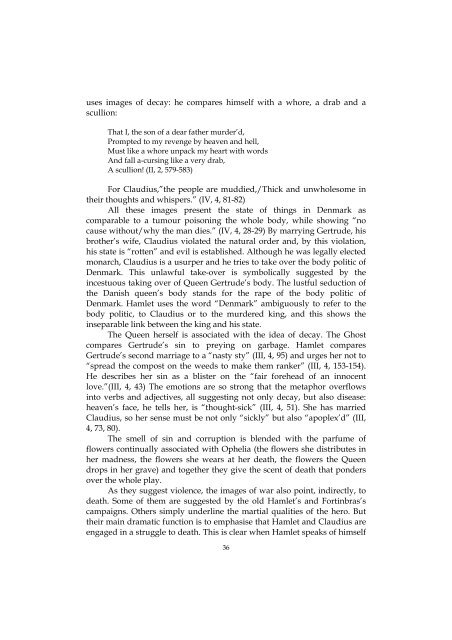translation studies. retrospective and prospective views
translation studies. retrospective and prospective views
translation studies. retrospective and prospective views
You also want an ePaper? Increase the reach of your titles
YUMPU automatically turns print PDFs into web optimized ePapers that Google loves.
uses images of decay: he compares himself with a whore, a drab <strong>and</strong> a<br />
scullion:<br />
That I, the son of a dear father murder’d,<br />
Prompted to my revenge by heaven <strong>and</strong> hell,<br />
Must like a whore unpack my heart with words<br />
And fall a-cursing like a very drab,<br />
A scullion! (II, 2, 579-583)<br />
For Claudius,”the people are muddied,/Thick <strong>and</strong> unwholesome in<br />
their thoughts <strong>and</strong> whispers.” (IV, 4, 81-82)<br />
All these images present the state of things in Denmark as<br />
comparable to a tumour poisoning the whole body, while showing “no<br />
cause without/why the man dies.” (IV, 4, 28-29) By marrying Gertrude, his<br />
brother’s wife, Claudius violated the natural order <strong>and</strong>, by this violation,<br />
his state is “rotten” <strong>and</strong> evil is established. Although he was legally elected<br />
monarch, Claudius is a usurper <strong>and</strong> he tries to take over the body politic of<br />
Denmark. This unlawful take-over is symbolically suggested by the<br />
incestuous taking over of Queen Gertrude’s body. The lustful seduction of<br />
the Danish queen’s body st<strong>and</strong>s for the rape of the body politic of<br />
Denmark. Hamlet uses the word “Denmark” ambiguously to refer to the<br />
body politic, to Claudius or to the murdered king, <strong>and</strong> this shows the<br />
inseparable link between the king <strong>and</strong> his state.<br />
The Queen herself is associated with the idea of decay. The Ghost<br />
compares Gertrude’s sin to preying on garbage. Hamlet compares<br />
Gertrude’s second marriage to a “nasty sty” (III, 4, 95) <strong>and</strong> urges her not to<br />
“spread the compost on the weeds to make them ranker” (III, 4, 153-154).<br />
He describes her sin as a blister on the “fair forehead of an innocent<br />
love.”(III, 4, 43) The emotions are so strong that the metaphor overflows<br />
into verbs <strong>and</strong> adjectives, all suggesting not only decay, but also disease:<br />
heaven’s face, he tells her, is “thought-sick” (III, 4, 51). She has married<br />
Claudius, so her sense must be not only “sickly” but also “apoplex’d” (III,<br />
4, 73, 80).<br />
The smell of sin <strong>and</strong> corruption is blended with the parfume of<br />
flowers continually associated with Ophelia (the flowers she distributes in<br />
her madness, the flowers she wears at her death, the flowers the Queen<br />
drops in her grave) <strong>and</strong> together they give the scent of death that ponders<br />
over the whole play.<br />
As they suggest violence, the images of war also point, indirectly, to<br />
death. Some of them are suggested by the old Hamlet’s <strong>and</strong> Fortinbras’s<br />
campaigns. Others simply underline the martial qualities of the hero. But<br />
their main dramatic function is to emphasise that Hamlet <strong>and</strong> Claudius are<br />
engaged in a struggle to death. This is clear when Hamlet speaks of himself<br />
36












